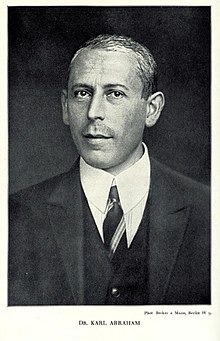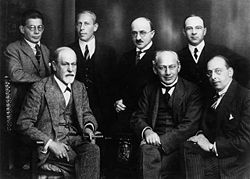Karl Abraham (original) (raw)
From Wikipedia, the free encyclopedia
German psychoanalyst (1877–1925)
| Karl Abraham | |
|---|---|
 Abraham, c. 1920 Abraham, c. 1920 |
|
| Born | 3 May 1877Bremen, German Empire |
| Died | 25 December 1925 (1925-12-26) (aged 48)Berlin, Weimar Republic |
| Scientific career | |
| Fields | Psychiatry |
Karl Abraham (German: [ˈaːbʁaham]; 3 May 1877 – 25 December 1925) was an influential German psychoanalyst, and a collaborator of Sigmund Freud, who called him his 'best pupil'.[1][2]
Abraham was born in Bremen, Germany. His parents were Nathan Abraham, a Jewish religion teacher (1842–1915), and his wife (and cousin) Ida (1847–1929).[3] His studies in medicine enabled him to take a position at the Burghölzli Swiss Mental Hospital, where Eugen Bleuler practiced. The setting of this hospital initially introduced him to the psychoanalysis of Carl Gustav Jung.[_citation needed_]
In 1907, he had his first contact with Sigmund Freud, with whom he developed a lifetime relationship. Returning to Germany, he founded the Berliner Society of Psychoanalysis in 1910.[4] He was the president of the International Psychoanalytical Association from 1914 to 1918 and again in 1925.
Karl Abraham collaborated with Freud on the understanding of manic-depressive illness, leading to Freud's paper on 'Mourning and Melancholia' in 1917. He was the analyst of Melanie Klein during the years 1924–1925, and of a number of other British psychoanalysts, including Edward Glover and Alix Strachey. He was a mentor for an influential group of German analysts, including Karen Horney, Helene Deutsch, and Franz Alexander.
Karl Abraham studied the role of infant sexuality in character development and mental illness and, like Freud, suggested that if psychosexual development is fixated at some point, mental disorders will likely emerge. He described the personality traits and psychopathology that result from the oral and anal stages of development (1921).[5]
Abraham observed his only daughter, Hilda, reporting on her reaction to enemas and infantile masturbation by her brother. He asked that secrets be shared with him but he was careful to respect her privacy and some reports were not published until after Hilda's death. Hilda was later to become a psychoanalyst.[6]
In the oral stage of development, the first relationships children have with objects (caretakers) determine their subsequent relationship to reality. Oral satisfaction can result in self-assurance and optimism, whereas oral fixation can lead to pessimism and depression. Moreover, a person with an oral fixation will present a disinclination to take care of themself and will require others to look after them. This may be expressed through extreme passivity (corresponding to the oral benign suckling substage) or through a highly active oral-sadistic behaviour (corresponding to the later sadistic biting substage).[5]
In the anal stage, when the training in cleanliness starts too early, conflicts may result between a conscious attitude of obedience and an unconscious desire for resistance. This can lead to traits such as frugality, orderliness and obstinacy, as well as to obsessional neurosis as a result of anal fixation (Abraham, 1921). In addition, Abraham based his understanding of manic-depressive illness on the study of the painter Segantini: an actual event of loss is not itself sufficient to bring the psychological disturbance involved in melancholic depression. This disturbance is linked with disappointing incidents of early childhood; in the case of men always with the mother (Abraham, 1911). This concept of the prooedipal “bad” mother was a new development in contrast to Freud’s oedipal mother and paved the way for the theories of Melanie Klein.[7]
Another important contribution is his work “A short study of the Development of the Libido”,[8] where he elaborated on Freud’s “Mourning and Melancholia” (1917) and demonstrated the vicissitudes of normal and pathological object relations and reactions to object loss.
Moreover, Abraham investigated child sexual trauma and, like Freud, proposed that sexual abuse was common among psychotic and neurotic patients. Furthermore, he argued (1907) that dementia praecox is associated with child sexual trauma, based on the relationship between hysteria and child sexual trauma demonstrated by Freud.
Abraham (1920) also showed interest in cultural issues. He analyzed various myths suggesting their relation to dreams (1909) and wrote an interpretation of the spiritual activities of the Egyptian monotheistic Pharaoh Amenhotep IV (1912).
Left to right, seated: Sigmund Freud, Sándor Ferenczi, and Hanns Sachs. Standing; Otto Rank, Karl Abraham, Max Eitingon, and Ernest Jones. Photo 1922
Abraham died prematurely on December 25, 1925, from complications of a lung infection and may have suffered from lung cancer.[9]
Works and publications
[edit]
- Normentafel zur Entwicklungsgeschichte des Huhnes (with Prof. Keibel). (1900) Normentafeln zur Entwicklungsgeschichte der Wirbeltiere, Heft 2. Jena.
- Beiträge zur Entwicklungsgeschichte des Wellensittichs. (inaugural dissertation.) (1901) Anatomische Blätter (Anatomical Institute, Freiburg), Heft LVI/LVII. (Wiesbaden, I. F. Bergmann.)
- Beiträge zur Kenntnis des Delirium tremens der Morphinisten. (1902) C., Jahrg. XXV, June, S. 369–80.
- ber Versuche mit 'Veronal' bei Erregungszuständen der Paralytiker. (1904) C., Jahrg.
- Abraham, K.(1907). On the significance of Sexual Trauma in Childhood for the Symptomatology of Dementia Praecox. In Hilda, C., Abraham, M.D.(Ed) (1955). Clinical Papers and Essays on Psycho-Analysis. London : The Hogarth Press and the Institute of Psychoanalysis.
- Abraham, K.(1909). Dreams and Myths : A study in folk-Psychology. In Hilda, C., Abraham, M.D.(Ed) (1955). Clinical Papers and Essays on Psycho-Analysis. London : The Hogarth Press and the Institute of Psychoanalysis.
- Abraham, K.(1911). Giovanni Segantini : A Psycho-analytical Study. In Hilda, C., Abraham, M.D.(Ed) (1955). Clinical Papers and Essays on Psycho-Analysis. London : The Hogarth Press and the Institute of Psychoanalysis.
- Abraham, K. (1912). Amenhotep IV. Psycho-analytical Contributions Towards the understanding of his Personality and of the Monotheistic Cult of Aton. . In Hilda, C., Abraham, M.D.(Ed) (1955). Clinical Papers and Essays on Psycho-Analysis. London : The Hogarth Press and the Institute of Psychoanalysis.
- Abraham, K. (1920). The Cultural Significance of Psycho-analysis. In Hilda, C., Abraham, M.D.(Ed) (1955). Clinical Papers and Essays on Psycho-Analysis. London : The Hogarth Press and the Institute of Psychoanalysis.
- Abraham, K (1921). Contributions to the theory of the anal character. In Stein, D.J, Stone, M. H. (Ed) (1997). Essential papers on obsessive-compulsive disorders. New York: New York University Press.
- Abraham, K The influence of oral erotism on character-formation. In Perzow, S. M., Kets de Vries, M.F.R. (Ed) (1991). Handbook of character studies: Psychoanalytic explorations. Madison, CT: International Universities Press.
- Abraham, K. A short study of the development of the libido. In Frankiel, R.V. (Ed) (1994). Essential papers on object loss, New York: New York University Press.
- ^ "Frequently Asked Questions". London: Freud Museum. Archived from the original on 26 June 2007. Retrieved 7 November 2018.
- ^ Bush, Lawrence (25 December 2014). "December 25: Freud's Best Pupil". Jewish Currents. Archived from the original on 8 November 2018. Retrieved 7 November 2018.
- ^ "DPG". Archived from the original on 18 July 2011. Retrieved 25 December 2010.
- ^ Sigmund Freud - Karl Abraham
- ^ a b Abraham, K, The influence of oral erotism on character-formation. In Perzow, S. M., Kets de Vries, M.F.R. (Ed) (1991). Handbook of character studies: Psychoanalytic explorations. Madison, CT: International Universities Press.
- ^ the late Pierre Geissmann; Claudine Geissmann (10 November 2005). A History of Child Psychoanalysis. Routledge. pp. 28–. ISBN 978-1-134-83003-9.
- ^ May-Tolzmann, 1997.
- ^ Abraham, K., A short study of the development of the libido. In Frankiel, R.V. (Ed) (1994). Essential papers on object loss, New York: New York University Press.
- ^ Hoffer, Axel. The Complete Correspondence of Sigmund Freud and Karl Abraham 1907-1925. American Imago. Volume 61, Number 1, Spring 2004
- May, Ulrike (2007), "[Remarks on the Introduction to Karl Abraham's collected works (1969-71)]", Luzifer-Amor : Zeitschrift zur Geschichte der Psychoanalyse, vol. 20, no. 39, pp. 145–52, PMID 17992845
- Kuhn, P (2000), "A scandal in Salzburg or Freud's surreptitious role in the 1908 Abraham-Jung dispute.", The International Journal of Psycho-analysis, vol. 81, no. 4 (published Aug 2000), pp. 705–31, doi:10.1516/0020757001600110, PMID 11028235
- Sklarew, B (1999), "Freud and film: encounters in the Weltgeist.", Journal of the American Psychoanalytic Association, vol. 47, no. 4, pp. 1238–47, PMID 10650559
- Machtlinger, V (1997), "[Karl Abraham and Giovanni Segantini]", Luzifer-Amor : Zeitschrift zur Geschichte der Psychoanalyse, vol. 10, no. 20, pp. 81–97, PMID 11625348
- Decke, B (1997), "[Karl Abraham: family, childhood and youth in Bremen]", Luzifer-Amor : Zeitschrift zur Geschichte der Psychoanalyse, vol. 10, no. 20, pp. 7–60, PMID 11625347
- Cremerius, J (1997), "[Karl Abraham, Freud's scapegoat and, guide to understanding the truth]", Luzifer-Amor : Zeitschrift zur Geschichte der Psychoanalyse, vol. 10, no. 20, pp. 64–80, PMID 11625346
- Good, M I (1995), "Karl Abraham, Sigmund Freud, and the fate of the seduction theory.", Journal of the American Psychoanalytic Association, vol. 43, no. 4, pp. 1137–67, doi:10.1177/000306519504300409, PMID 8926328, S2CID 26778091
- May-Tolzmann, U. (1997). The Discovery of the Bad Mother: Abraham’s contribution to the theory of Depression. Luzifer-Amor: Zeitschrift zur Geschichte der Psychoanalyse, 10(20), 98-131.
- Shengold, L (1972), "A parapraxis of Freud's in relation to Karl Abraham.", The American Imago; A Psychoanalytic Journal for the Arts and Sciences, vol. 29, no. 2, pp. 123–59, PMID 4562662
- Freud, S. (1917). Mourning and Melancholia. Standard Edition, 14, 305-307.
- Selected Papers on Psycho-Analysis, Publisher: Karnac Books; 1997, ISBN 0-9501647-7-1
- International Psychoanalytical Association
